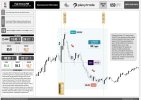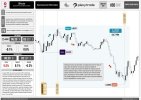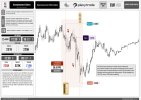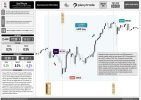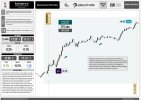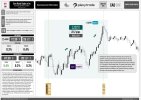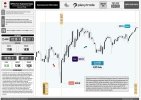24th October 2024
Thursday
On Thursday, major economic reports are set to be released, with significant attention on the flash manufacturing and services PMI figures from France, Germany, the UK, and the US. These reports will provide critical insights into the health of key sectors in each economy. Additionally, the US will release its latest unemployment claims data, which will be closely watched for signs of labor market strength or weakness. These reports are expected to have a notable impact on global financial markets as investors assess the state of economic recovery in these major economies.
EUR - French Flash Manufacturing PMI
The Manufacturing Purchasing Managers Index (PMI), provided by S&P Global and Hamburg Commercial Bank (HCOB), is an essential indicator for France's manufacturing sector, which plays a significant role in the national GDP. This index reflects the business conditions within the sector, with a PMI score above 50 signaling optimistic economic prospects and bullish market conditions for the Euro, while a score below 50 indicates bearish conditions potentially harmful to the currency. Traders closely monitor the PMI because it acts as a leading economic health indicator, with purchasing managers offering timely and pertinent insights into market conditions and the company's economic expectations.
In September 2024, the S&P Global France Manufacturing PMI rose to 44.6 from 43.9 in August, slightly higher than the preliminary reading of 44. Despite this improvement, it marked the 20th consecutive month of contraction, although the decline was the mildest since May. Output and new orders continued to decrease sharply due to weak demand, but the pace of contraction eased slightly. The consumer goods sector neared stabilization, while the intermediate and capital goods sectors remained in steep decline. Purchasing activity was reduced, and pre-production stocks fell at the fastest rate in nearly four-and-a-half years. Employment also declined, though at the slowest rate in five months. On the price front, input cost pressures eased, partly due to lower metal prices, while selling prices showed only a slight increase. French manufacturers were the most pessimistic they had been since January, driven in part by ongoing political uncertainty in the country.
TL;DR
| Category | September 2024 | Comparison with August 2024 |
|---|
| PMI Index | 44.6 | Increased from 43.9 (August) |
| Preliminary PMI Reading | 44 | Final slightly higher than prelim |
| Consecutive Months of Contraction | 20 months | Continued contraction |
| Output and New Orders | Decreased sharply | Eased slightly in pace |
| Consumer Goods Sector | Nearing stabilization | Improved over prior month |
| Intermediate & Capital Goods | Steep decline | No improvement |
| Purchasing Activity | Reduced | Continued reduction |
| Pre-production Stocks | Fell at fastest rate in 4.5 years | Significant drop |
| Employment | Declined | Slowest decline in 5 months |
| Input Cost Pressures | Eased | Due to lower metal prices |
| Selling Prices | Slight increase | Minimal change |
| Business Sentiment | Most pessimistic since January 2024 | Driven by political uncertainty |
The forecast is indicating
44.9 compared to previous
44.6 outcome.

EUR - French Flash Services PMI
The French Flash Services PMI is a key measure of economic health, derived from a survey of around 750 purchasing managers in the services sector. It provides a diffusion index based on their assessment of business conditions, including factors like employment, production, new orders, prices, supplier deliveries, and inventories. Traders pay close attention to this indicator because it reflects current market conditions and business sentiment. A result higher than the forecast is typically viewed as positive for the currency, as purchasing managers often have the most up-to-date insights into their company's economic outlook.
In September 2024, the HCOB France Services PMI dropped to 49.6, exceeding preliminary estimates of 48.3 but marking a significant decline from 55 in August. The sharp contraction was largely attributed to a decrease in visitor and customer numbers following the temporary boost from the Paris Olympic Games. New business volumes continued to shrink, with demand weakening in overseas markets, marking the third decline in four months. Output also decreased, though only marginally. Despite these setbacks, employment rose for the 48th consecutive month, albeit at a slower pace. Input cost inflation eased significantly, hitting its lowest level in over three years, while output prices stabilized, ending a 40-month streak of increases. Despite these challenges, service providers remained optimistic, expecting stronger demand by the end of the year and into early 2025.
TL;DR
| Metric | September 2024 | Comments |
|---|
| PMI | 49.6 | Exceeded preliminary estimate of 48.3, but down from 55 in August. |
| Visitor & Customer Numbers | Decrease | Drop attributed to the post-Olympic Games effect. |
| New Business Volumes | Shrink | Third decline in four months; weaker overseas demand. |
| Output | Marginal decrease | Though output decreased, the decline was slight. |
| Employment | Rose for 48th consecutive month | Growth at a slower pace. |
| Input Cost Inflation | Eased significantly | Lowest level in over three years. |
| Output Prices | Stabilized | Ended a 40-month streak of increases. |
| Business Outlook | Optimistic | Service providers expect stronger demand by late 2024 and early 2025. |
The forecast predicts a slight improvement, with a projected figure of
49.8, up from the previous outcome of
49.6.
The
French Flash Manufacturing & Services PMI is set to be released on
Thursday at
7:15 AM GMT.

EUR - German Flash Manufacturing PMI
The German Flash Manufacturing PMI measures the performance of the manufacturing sector through a survey of about 800 purchasing managers, assessing business conditions such as employment, production, and new orders. A reading above 50 indicates expansion, while below 50 signals contraction. Traders monitor this as a key economic indicator, as purchasing managers offer real-time insights into market conditions. A result higher than the forecast is positive for the currency, reflecting potential economic growth.
In September 2024, Germany's HCOB Manufacturing PMI dropped to 40.6, down from 42.4 in the previous month, marking its lowest point in a year. Although the final reading was revised slightly higher than the preliminary estimate of 40.3, it remained significantly below initial expectations of 42.3. The data highlighted a deepening contraction in the country's manufacturing sector, a critical factor in the Eurozone's overall sluggish output. New orders saw a sharp decline, with companies citing market uncertainty, reduced investment, customer destocking, and notable weakness in the auto manufacturing industry. As a result, production fell despite a reduction in work backlogs, while lower demand led to a continued drop in purchasing activity and employment levels, which sank at the fastest rate in four years. Meanwhile, decreased input demand caused both purchasing prices and output charges to decline.
TL;DR
| HCOB Manufacturing PMI (Sept 2024) | 40.6 (down from 42.4 in August 2024) |
| Final Reading | 40.6 (revised up from preliminary estimate of 40.3) |
| Sector Impact | Deepening contraction in Germany's manufacturing sector |
| New Orders | Sharp decline due to market uncertainty, reduced investment, customer destocking, and weakness in the auto industry |
| Production | Declined despite reduced work backlogs |
| Purchasing Activity | Continued decline due to lower demand |
| Employment Levels | Declined at the fastest rate in 4 years |
| Purchasing Prices & Output Charges | Both declined due to decreased input demand |
The forecast indicates a slight rise to
40.7, compared to the previous outcome of
40.6.
The
German Flash Manufacturing & Services PMI is scheduled for release on
Thursday at
7:30 AM GMT.

EUR - German Flash Services PMI
The German Flash Services PMI measures the level of business activity in the services sector through a diffusion index based on a survey of around 800 purchasing managers. A reading above 50 indicates expansion, while below 50 signals contraction. If the 'Actual' figure exceeds the forecast, it's positive for the currency. This index is a leading indicator of economic health, as purchasing managers provide current insights into business conditions such as employment, production, new orders, prices, and supplier deliveries.
Germany's services sector saw a slowdown in September 2024, with the HCOB Flash Services PMI Business Activity Index dropping to 50.6 from 51.2 in August, marking a six-month low and the fourth consecutive month of decline. The report, compiled by S&P Global, indicated a sharp contraction in the country’s private sector, with a notable drop in manufacturing production and a near-stall in services growth. New business orders, including exports, fell at their fastest rate in nearly a year, and workforce numbers were cut for the third month. Inflationary pressures eased significantly, with input and output price increases in services at their slowest since April 2021. Despite remaining positive, business sentiment for the year ahead hit a 12-month low, as concerns over the economy and key sectors like automotive and construction weighed heavily on expectations.
TL;DR
| Aspect | Details |
|---|
| Event | Slowdown in Germany's services sector |
| Month | September 2024 |
| PMI Business Activity Index | Dropped to 50.6 (from 51.2 in August) |
| Key Indicators | Six-month low, fourth consecutive month of decline |
| Private Sector Impact | Sharp contraction in manufacturing, near-stall in services growth |
| New Business Orders | Fell at fastest rate in nearly a year |
| Workforce | Cut for the third consecutive month |
| Inflationary Pressures | Eased significantly, slowest price increases since April 2021 |
| Business Sentiment | 12-month low |
| Sector-Specific Concerns | Automotive and construction |
The forecast shows
50.6, remaining unchanged from the previous outcome.

GBP - Flash Manufacturing PMI
The Manufacturing Purchasing Managers Index (PMI) from the Chartered Institute of Procurement & Supply and S&P Global is a crucial monthly indicator for the UK's manufacturing sector, derived from surveys of senior executives. It gauges changes in business activity, predicting shifts in GDP, industrial production, employment, and inflation. The index operates on a 0-100 scale; readings above 50 indicate sector expansion (positive for the Pound Sterling), while below 50 suggests contraction (negative for the currency). Traders value the PMI for its immediate insights into economic health provided by purchasing managers.
In September 2024, the S&P Global Flash UK Manufacturing PMI dropped to 51.5, a three-month low from August's 52.5, signaling slower growth in the sector. The decline reflects a cautious approach by clients ahead of the Autumn Budget, subdued export orders—particularly from the EU—and renewed job cuts in manufacturing. Despite weaker demand, supply chain disruptions, notably ocean freight delays due to the Red Sea crisis, extended delivery times. Inflationary pressures persisted, with purchase price inflation reaching its highest level since January 2023, driven by rising wages and shipping costs. However, private sector prices charged for goods and services saw their slowest increase since February 2021, suggesting cooling inflation. Overall, the UK private sector continued its expansion for the 11th consecutive month, but growth in both manufacturing and services slowed.
TL;DR
| Key Aspect | Details |
|---|
| S&P Global Flash UK Manufacturing PMI | Dropped to 51.5 in September 2024, down from 52.5 in August (3-month low) |
| Sector Growth | Slower growth in manufacturing |
| Client Approach | Cautious approach ahead of the Autumn Budget |
| Export Orders | Subdued, particularly from the EU |
| Job Market | Renewed job cuts in manufacturing |
| Supply Chain Disruptions | Ocean freight delays, especially due to the Red Sea crisis |
| Delivery Times | Extended due to supply chain issues |
| Purchase Price Inflation | Highest level since January 2023, driven by rising wages and shipping costs |
| Private Sector Prices (Goods & Services) | Slowest increase in prices since February 2021, indicating cooling inflation |
| UK Private Sector Expansion | Continued expansion for 11th consecutive month, but growth slowed in both manufacturing and services |
The forecast remains
unchanged at
51.5, the same as the previous figure.
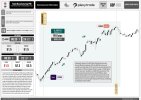
GBP - Flash Services PMI
The Services Purchasing Managers Index (PMI), issued monthly by the Chartered Institute of Procurement & Supply and S&P Global, is a vital indicator of the UK's services sector health. Ranging from 0 to 100, a PMI above 50 indicates sector expansion, boosting the Pound Sterling (GBP), while below 50 suggests contraction, negatively impacting GBP. This index is closely watched by traders as it provides real-time insights into economic conditions from the perspective of purchasing managers.
In September 2024, the S&P Global UK Services PMI dropped to 52.4, down from 53.7 in August and revised lower from an initial estimate of 52.8. While the pace of growth moderated, business activity remained robust, supported by strong domestic demand, particularly in sectors such as technology, real estate, and leisure services. New business volumes continued to expand, approaching the 14-month peak seen in July. However, export orders grew at a slower rate than overall new business, highlighting weaker overseas demand as a persistent issue. Employment gains also slowed, with hiring activity falling significantly to a three-month low. On the pricing front, cost pressures increased, largely driven by rising wages, but competitive forces limited price hikes, leading to the slowest rise in output charges since February 2021. Despite these challenges, business outlook for the year ahead remained positive.
TL;DR
| S&P Global UK Services PMI (Sep 2024) | 52.4 (down from 53.7 in August) |
| Initial Estimate (Sep 2024) | Revised lower from 52.8 |
| Business Activity | Remained robust, supported by strong domestic demand |
| Key Sectors | Technology, real estate, leisure services |
| New Business Volumes | Expanded, nearing the 14-month peak seen in July |
| Export Orders | Grew slower than overall new business, indicating weaker overseas demand |
| Employment Gains | Slowed significantly, reaching a three-month low |
| Hiring Activity | Fell significantly |
| Cost Pressures | Increased, mainly due to rising wages |
| Output Charges | Slowest rise since February 2021 due to competitive pressures limiting price hikes |
| Business Outlook | Remained positive despite challenges |
The forecast suggests a slight decrease to
52.3, compared to the previous outcome of
52.4.
The
Flash Manufacturing & Services PMI is set to be released on
Thursday at
8:30 AM GMT.

USD - Unemployment Claims
Unemployment claims measure the number of people who filed for unemployment benefits for the first time in the past week. If the actual figure is lower than the forecast, it is generally positive for the currency. Although seen as a lagging indicator, unemployment is an important reflection of economic health since consumer spending is closely linked to labor conditions. Additionally, unemployment levels play a crucial role in influencing the country's monetary policy decisions.
In the week ending October 12, U.S. unemployment claims dropped by 19,000 to 241,000, the largest decrease in three months after reaching a 14-month high the previous week. This figure came in below market expectations of 260,000, with the decline following disruptions caused by Hurricanes Helene and Milton. Despite the decrease, claims remain elevated compared to earlier in the year, signaling a cooling labor market after its post-pandemic peak. Continuing claims for the week ending October 5 rose by 9,000 to 1,867,000, while the four-week moving average for initial claims increased by 4,750 to 236,250. Non-seasonally adjusted claims fell by 11,416, with notable decreases in Michigan and Florida.
TL;DR
| Metric | Value | Notes |
|---|
| Initial Unemployment Claims (Week Ending Oct 12) | 241,000 | Decreased by 19,000, largest decrease in three months |
| Market Expectation for Initial Claims | 260,000 | Actual claims were below expectations |
| Initial Claims (Previous Week) | 14-month high | Affected by Hurricanes Helene and Milton |
| Continuing Claims (Week Ending Oct 5) | 1,867,000 | Increased by 9,000 |
| 4-Week Moving Average for Initial Claims | 236,250 | Increased by 4,750 |
| Non-Seasonally Adjusted Claims | -11,416 | Decrease in non-seasonally adjusted claims, particularly in Michigan and Florida |
The forecast projects
243,000, slightly higher than the previous outcome of
241,000.
The
Unemployment Claims report is scheduled for release on
Thursday at
12:30 PM GMT.

USD - Flash Manufacturing PMI
The S&P Global Manufacturing Purchasing Managers Index (PMI) is a crucial monthly indicator for the US manufacturing sector, derived from surveys of senior executives. It measures business activity, with a score above 50 indicating expansion and below 50 signifying contraction. This data helps predict trends in GDP, industrial production, employment, and inflation, and significantly influences the US Dollar's value. Traders value it as a leading economic health indicator, reflecting immediate market conditions from a managerial perspective.
The S&P Global US Manufacturing PMI was revised upward to 47.3 in September 2024, slightly higher than the preliminary estimate of 47, but still marking the lowest level since June 2023. This reflects the third consecutive month of contraction in the sector, driven by sharp declines in both output and new orders amid weakened demand and ongoing political uncertainty. Employment levels also fell at the steepest rate since 2010, excluding the pandemic period. Despite these challenges, business confidence saw a modest improvement, with optimism focused on a potential demand recovery following the upcoming election. Input cost inflation eased, though it remained elevated, and companies raised prices at the fastest rate since April.
TL;DR
| Indicator | Details for September 2024 |
|---|
| S&P Global US Manufacturing PMI | 47.3 (Revised from 47, lowest since June 2023) |
| Trend | Third consecutive month of contraction |
| Output | Sharp decline due to weakened demand and political uncertainty |
| New Orders | Sharp decline |
| Employment Levels | Fell at the steepest rate since 2010 (excluding the pandemic period) |
| Business Confidence | Modest improvement, optimism due to potential recovery post-election |
| Input Cost Inflation | Eased, but still elevated |
| Prices Raised | Companies raised prices at the fastest rate since April |
The forecast points to
47.5, slightly higher than the previous outcome of
47.3.

USD - Flash Services PMI
The S&P Global Services Purchasing Managers Index (PMI) is a crucial monthly indicator for the US services sector, which constitutes a significant portion of the economy. This index is derived from surveys of senior executives in private sector service companies, reflecting month-over-month changes in business activity. A PMI reading above 50 suggests expansion in the services sector, positively influencing the US Dollar, while a reading below 50 indicates contraction, which could negatively impact the currency. Traders value this data as it serves as a leading indicator of economic health, providing insights from purchasing managers who have timely and relevant perspectives on market conditions.
The S&P Global US Services PMI for September 2024 was revised down slightly to 55.2 from a preliminary 55.4, marking a modest decline from August's 55.7 but still reflecting robust growth in the services sector. Despite solid increases in new business, companies were cautious about hiring due to rising input costs, which surged at the joint-fastest rate in a year, contributing to faster selling price inflation. Business confidence dropped to its lowest point since October 2022, as concerns about an economic slowdown mounted. Employment fell for the second consecutive month, exacerbating staff shortages, while backlogs of work grew at the fastest rate since January, driven by strong new orders and understaffing challenges.
TL;DR
| US Services PMI (Sep 2024, Revised) | 55.2 (Revised from 55.4) |
| US Services PMI (Aug 2024) | 55.7 |
| New Business | Solid increases |
| Input Costs | Surged (Joint-fastest rate in a year) |
| Selling Price Inflation | Faster |
| Business Confidence | Lowest since October 2022 |
| Employment | Fell for second consecutive month |
| Backlogs of Work | Grew at fastest rate since January |
The forecast suggests a slight decrease to
55.0, compared to the previous outcome of
55.2.
The
Flash Manufacturing and Services PMI is scheduled for release on
Thursday at
1:45 PM GMT.
